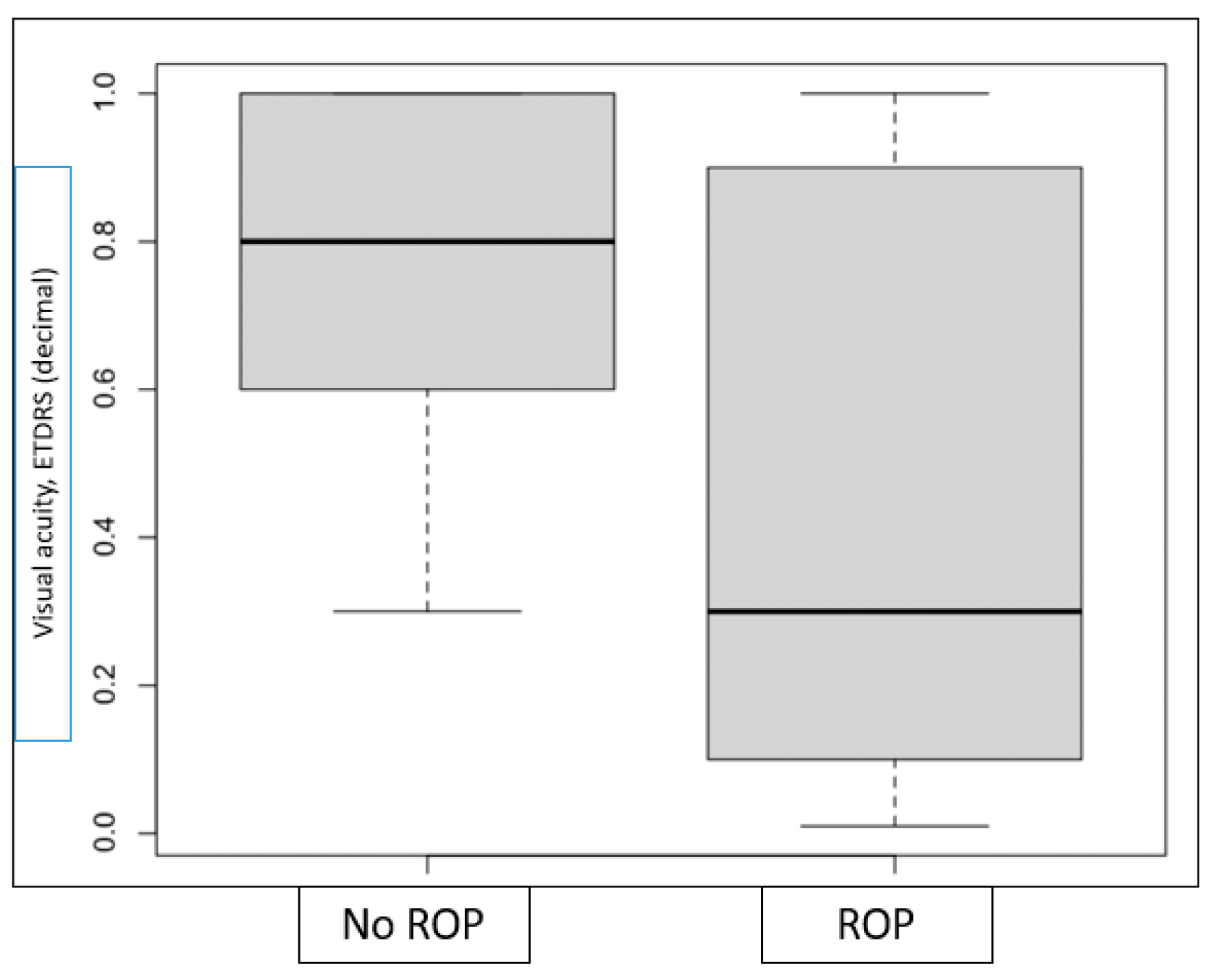Oculomotor Control in Preterm Infants: Insights from Eye-Tracking Technology
Abstract
1. Introduction
2. Materials and Methods
2.1. Participants
2.2. Examination
2.2.1. Ophthalmological Assessment
2.2.2. Fixation Stability Assessment
2.2.3. Equipment
2.2.4. Calibration and Study
2.2.5. Analysis of Fixations
2.2.6. Statistical Analysis
3. Results
4. Discussion
4.1. Main Finding
4.2. Importance of Fixation Stability
4.3. Development of Visual Fixation Physiology
4.4. Consequences of Impaired Visual Fixation
4.5. Different Oculomotor Control Patterns
4.6. Future Directions
5. Conclusions
Author Contributions
Funding
Institutional Review Board Statement
Informed Consent Statement
Data Availability Statement
Conflicts of Interest
References
- Pierrat, V.; Marchand-Martin, L.; Arnaud, C.; Kaminski, M.; Resche-Rigon, M.; Lebeaux, C.; Bodeau-Livinec, F.; Morgan, A.S.; Goffinet, F.; Marret, S.; et al. Neurodevelopmental outcome at 2 years for preterm children born at 22 to 34 weeks’ gestation in France in 2011: EPIPAGE-2 cohort study. BMJ 2017, 358, j3448. [Google Scholar] [CrossRef]
- Charkaluk, M.L.; Kana, G.D.; Benhammou, V.; Guellec, I.; Letouzey, M.; Morgan, A.S.; Nuytten, A.; Torchin, H.; Twilhaar, S.; Cambonie, G.; et al. Neurodevelopment at age 5.5 years according to Ages & Stages Questionnaire at 2 years’ corrected age in children born preterm: The EPIPAGE-2 cohort study. Arch. Dis. Child Fetal Neonatal Ed. 2024, 109, 519–526. [Google Scholar] [CrossRef]
- Atkinson, J.; Braddick, O. Visual and visuocognitive development in children born very prematurely. Prog. Brain Res. 2007, 164, 123–149. [Google Scholar] [CrossRef]
- EXPRESS Group; Fellman, V.; Hellström-Westas, L.; Norman, M.; Westgren, M.; Källén, K.; Lagercrantz, H.; Marsál, K.; Serenius, F.; Wennergren, M. One-year survival of extremely preterm infants after active perinatal care in Sweden. JAMA 2009, 301, 2225–2233. [Google Scholar] [CrossRef]
- Roberts, G.; Anderson, P.J.; De Luca, C.; Doyle, L.W. Victorian Infant Collaborative Study Group. Changes in neurodevelopmental outcome at age eight in geographic cohorts of children born at 22–27 weeks’ gestational age during the 1990s. Arch. Dis. Child. Fetal Neonatal Ed. 2010, 95, F90–F94. [Google Scholar] [CrossRef] [PubMed]
- Strand-Brodd, K.; Ewald, U.; Grönqvist, H.; Holmström, G.; Strömberg, B.; Grönqvist, E.; von Hofsten, C.; Rosander, K. Development of smooth pursuit eye movements in very preterm infants: 1. General aspects. Acta Paediatr. 2011, 100, 983–991. [Google Scholar] [CrossRef] [PubMed]
- Fazzi, E.; Bova, S.; Giovenzana, A.; Signorini, S.; Uggetti, C.; Bianchi, P. Cognitive visual dysfunctions in preterm children with periventricular leukomalacia. Dev. Med. Child. Neurol. 2009, 51, 974–981. [Google Scholar] [CrossRef] [PubMed]
- Parikh, N.A. Advanced neuroimaging and its role in predicting neurodevelopmental outcomes in very preterm infants. Semin. Perinatol. 2016, 40, 530–541. [Google Scholar] [CrossRef]
- Bolisetty, S.; Tiwari, M.; Sutton, L.; Schindler, T.; Bajuk, B.; Lui, K.; New South Wales and the Australian Capital Territory Neonatal Intensive Care Units’ Data Registry. Neurodevelopmental outcomes of extremely preterm infants in New South Wales and the Australian Capital Territory. J. Paediatr. Child Health 2018, 55, 956–961. [Google Scholar] [CrossRef]
- Stjerna, S.; Sairanen, V.; Gröhn, R.; Andersson, S.; Metsäranta, M.; Lano, A.; Vanhatalo, S. Visual fixation in human newborns correlates with extensive white matter networks and predicts long-term neurocognitive development. J. Neurosci. 2015, 35, 4824–4829. [Google Scholar] [CrossRef]
- Aring, E.; Grönlund, M.A.; Hellström, A.; Ygge, J. Visual fixation development in children. Graefe’s Arch. Clin. Exp. Ophthalmol. 2007, 245, 1659–1665. [Google Scholar] [CrossRef]
- Kaul, Y.F.; Rosander, K.; von Hofsten, C.; Brodd, K.S.; Holmström, G.; Kaul, A.; Böhm, B.; Hellström-Westas, L. Visual tracking in very preterm infants at 4 mo predicts neurodevelopment at 3 y of age. Pediatr. Res. 2016, 80, 35–42. [Google Scholar] [CrossRef]
- Bilbao, C.; Piñero, D.P. Diagnosis of oculomotor anomalies in children with learning disorders. Clin. Exp. Optom. 2020, 103, 597–609. [Google Scholar] [CrossRef]
- Bolisetty, S.; Dhawan, A.; Abdel-Latif, M.; Bajuk, B.; Stack, J.; Lui, K.; New South Wales and Australian Capital Territory Neonatal Intensive Care Units’ Data Collection. Intraventricular hemorrhage and neurodevelopmental outcomes in extreme preterm infants. Pediatrics 2014, 133, 55–62. [Google Scholar] [CrossRef] [PubMed]
- Phadke, A.; Msall, M.E.; Droste, P.; Allred, E.N.; O’SHea, T.M.; Kuban, K.; Dammann, O.; Leviton, A. Impaired visual fixation at the age of 2 years in children born before the twenty-eighth week of gestation. Antecedents and correlates in the multicenter ELGAN study. Pediatr. Neurol. 2014, 51, 36–42. [Google Scholar] [CrossRef]
- Chorna, O.; Corsi, G.; Del Secco, S.; Bancale, A.; Guzzetta, A. Correlation between Early Visual Functions and Cognitive Outcome in Infants at Risk for Cerebral Palsy or Other Neurodevelopmental Disorders: A Systematic Review. Children 2024, 11, 747. [Google Scholar] [CrossRef] [PubMed]
- Krauzlis, R.J.; Goffart, L.; Hafed, Z.M. Neuronal control of fixation and fixational eye movements. Philos. Trans. R. Soc. B Biol. Sci. 2017, 372, 20160205. [Google Scholar] [CrossRef]
- Downes, M.; Kelly, D.; Day, K.; Marlow, N.; de Haan, M. Visual attention control differences in 12-month-old preterm infants. Infant. Behav. Dev. 2018, 50, 180–188. [Google Scholar] [CrossRef]
- Romeo, D.M.; Ricci, D.; Serrao, F.; Gallini, F.; Olivieri, G.; Cota, F.; Romagnoli, C.; Mercuri, E. Visual function assessment in late-preterm newborns. Early Hum. Dev. 2012, 88, 301–305. [Google Scholar] [CrossRef]
- Ricci, D.; Cesarini, L.; Romeo, D.M.; Gallini, F.; Serrao, F.; Groppo, M.; De Carli, A.; Cota, F.; Lepore, D.; Molle, F.; et al. Visual function at 35 and 40 weeks’ postmenstrual age in low-risk preterm infants. Pediatrics 2008, 122, e1193–e1198. [Google Scholar] [CrossRef]
- Dean, B.; Ginnell, L.; Ledsham, V.; Tsanas, A.; Telford, E.; Sparrow, S.; Fletcher-Watson, S.; Boardman, J.P. Eye-tracking for longitudinal assessment of social cognition in children born preterm. J. Child. Psychol. Psychiatry 2021, 62, 470–480. [Google Scholar] [CrossRef]
- Ploner, C.J.; Gaymard, B.M.; Rivaud-Péchoux, S.; Pierrot-Deseilligny, C. The prefrontal substrate of reflexive saccade inhibition in humans. Biol. Psychiatry 2005, 57, 1159–1165. [Google Scholar] [CrossRef] [PubMed]
- Barash, S.; Melikyan, A.; Sivakov, A.; Zhang, M.; Glickstein, M.; Thier, P. Saccadic dysmetria and adaptation after lesions of the cerebellar cortex. J. Neurosci. 1999, 19, 10931–10939. [Google Scholar] [CrossRef] [PubMed][Green Version]
- Takagi, M.; Zee, D.S.; Tamargo, R.J. Effects of lesions of the oculomotor cerebellar vermis on eye movements in primate: Smooth pursuit. J. Neurophysiol. 2000, 83, 2047–2062. [Google Scholar] [CrossRef] [PubMed]
- Pel, J.J.M.; Dudink, J.; Vonk, M.; Plaisier, A.; Reiss, I.K.M.; van der Steen, J. Early identification of cerebral visual impairments in infants born extremely preterm. Dev. Med. Child. Neurol. 2016, 58, 1030–1035. [Google Scholar] [CrossRef]





| Preterm Children | Full-Term Children | ||
|---|---|---|---|
| Mean birth weight (g) | 1496.14 ± 613.19 | 3231.94 ± 407.94 | p < 0.001 |
| Mean gestational age at birth (weeks) | 30.54 ± 3.5 | 39.14 ± 1.15 | p < 0.001 |
| Adjusted age at testing (years) | 4.17 ± 3.07 | 4.06 ± 3.08 | p = 0.897 |
| Spherical Equivalent right eye (D) | 1.57 ± 2.38 | 1.17 ± 1.24 | p < 0.001 |
| Spherical Equivalent left eye (D) | 1.64 ± 2.24 | 1.18 ± 1.21 | p < 0.001 |
| Astigmatism right eye (D) | 1.04 ± 0.91 | 0.68 ± 0.43 | p < 0.001 |
| Astigmatism left eye (D) | 1.09 ± 0.94 | 0.65 ± 0.42 | p < 0.001 |
| Fixation Stability (BCEA, log deg2) | Median Fixation Duration (s) | Saccadic Reaction Time (s) | |
|---|---|---|---|
| Preterm | 0.21 ± 0.4 | 0.35 ± 0.1 | 0.30 ± 0.09 |
| Control | 0.09 ± 0.4 | 0.37 ± 0.1 | 0.28 ± 0.08 |
| p = 0.004 | p = 0.057 | p = 0.032 |
| Mean Gestational Age (Weeks) | Fixation Stability (BCEA, log deg2) | Median Fixation Duration (s) | Saccadic Reaction Time (s) | |
|---|---|---|---|---|
| Early preterm | 28.48 | 0.26 ± 0.4 | 0.33 ± 0.09 | 0.29 ± 0.09 |
| Late preterm | 34.66 | 0.12 ± 0.4 | 0.35 ± 0.13 | 0.30 ±0.08 |
| Control | 39.24 | 0.09 ± 0.4 | 0.37 ± 0.12 | 0.28 ± 0.08 |
| p = 0.001 | p = 0.132 | p = 0.098 |
| Fixation Stability (BCEA, log deg2) | Median Fixation Duration (s) | Saccadic Reaction Time (s) | |
|---|---|---|---|
| Preterm | 0.22 ± 0.39 | 0.34 ± 0.09 | 0.30 ± 0.08 |
| Control | 0.07 ± 0.39 | 0.37 ± 0.11 | 0.28 ± 0.08 |
| p = 0.001 | p = 0.021 | p = 0.031 |
| Cluster 1 “Poor OMC” | Cluster 2 “Impulsive OMC” | Cluster 3 “Good OMC” | p-Value | |
|---|---|---|---|---|
| Fixation stability, BCEA (logdeg2) | 0.45 ± 0.36 | 0.18 ± 0.36 | −0.17 ± 0.27 | <0.001 |
| Fixation duration (ms) | 0.31 ± 0.07 | 0.32 ± 0.06 | 0.46 ± 0.13 | <0.001 |
| Saccadic reaction time (ms) | 0.34 ± 0.09 | 0.23 ± 0.05 | 0.31 ± 0.08 | <0.001 |
| N | 140 | 140 | 137 |
| Cluster 1 “Poor OMC” | Cluster 2 “Impulsive OMC” | Cluster 3 “Good OMC” | p-Value | |
|---|---|---|---|---|
| Age (y) | 4.37 ± 3.33 | 4.07 ± 2.81 | 3.81 ± 3.03 | 0.314 |
| Gender (male/female) | 61:79 | 67:70 | 68:72 | 0.221 |
| Gestational age (weeks) | 33.89 ± 5.18 | 35.20 ± 5.07 | 35.47 ± 4.75 | 0.019 |
| Birth weight (g) | 2159.23 ± 1018.62 | 2446.29 ± 1052.96 | 2490.97 ± 940.73 | 0.012 |
| Prematurity (rate) | 61.4% | 43.8% | 44.3% | 0.004 |
| Extreme prematurity (rate) | 39.3% | 29.9% | 26.4% | 0.016 |
| Maternal corioamnionitis | 20.9% | 16.7% | 16.1% | 0.704 |
| Intraventricular haemorrhage (rate) | 15.7% | 13.9% | 6.4% | 0.041 |
| Bronchopulmonary dysplasia | 23.2% | 25% | 12.9% | 0.190 |
| Visual disorders (refraction, strabismus) | 23.6% | 10.2% | 12.1% | 0.004 |
| N | 140 | 140 | 137 |
Disclaimer/Publisher’s Note: The statements, opinions and data contained in all publications are solely those of the individual author(s) and contributor(s) and not of MDPI and/or the editor(s). MDPI and/or the editor(s) disclaim responsibility for any injury to people or property resulting from any ideas, methods, instructions or products referred to in the content. |
© 2025 by the authors. Licensee MDPI, Basel, Switzerland. This article is an open access article distributed under the terms and conditions of the Creative Commons Attribution (CC BY) license (https://creativecommons.org/licenses/by/4.0/).
Share and Cite
Romero-Sanz, M.; Pérez-Roche, T.; Vilella Cenis, M.; Alejandre Escriche, A.; Esteban-Ibañez, E.; Ortin Obon, M.; Lacort-Beltrán, M.; Prieto Calvo, E.; Castillo Castejón, O.; Pueyo Royo, V. Oculomotor Control in Preterm Infants: Insights from Eye-Tracking Technology. J. Clin. Med. 2025, 14, 7742. https://doi.org/10.3390/jcm14217742
Romero-Sanz M, Pérez-Roche T, Vilella Cenis M, Alejandre Escriche A, Esteban-Ibañez E, Ortin Obon M, Lacort-Beltrán M, Prieto Calvo E, Castillo Castejón O, Pueyo Royo V. Oculomotor Control in Preterm Infants: Insights from Eye-Tracking Technology. Journal of Clinical Medicine. 2025; 14(21):7742. https://doi.org/10.3390/jcm14217742
Chicago/Turabian StyleRomero-Sanz, María, Teresa Pérez-Roche, Marina Vilella Cenis, Adrián Alejandre Escriche, Eduardo Esteban-Ibañez, Marta Ortin Obon, Marta Lacort-Beltrán, Esther Prieto Calvo, Olimpia Castillo Castejón, and Victoria Pueyo Royo. 2025. "Oculomotor Control in Preterm Infants: Insights from Eye-Tracking Technology" Journal of Clinical Medicine 14, no. 21: 7742. https://doi.org/10.3390/jcm14217742
APA StyleRomero-Sanz, M., Pérez-Roche, T., Vilella Cenis, M., Alejandre Escriche, A., Esteban-Ibañez, E., Ortin Obon, M., Lacort-Beltrán, M., Prieto Calvo, E., Castillo Castejón, O., & Pueyo Royo, V. (2025). Oculomotor Control in Preterm Infants: Insights from Eye-Tracking Technology. Journal of Clinical Medicine, 14(21), 7742. https://doi.org/10.3390/jcm14217742







